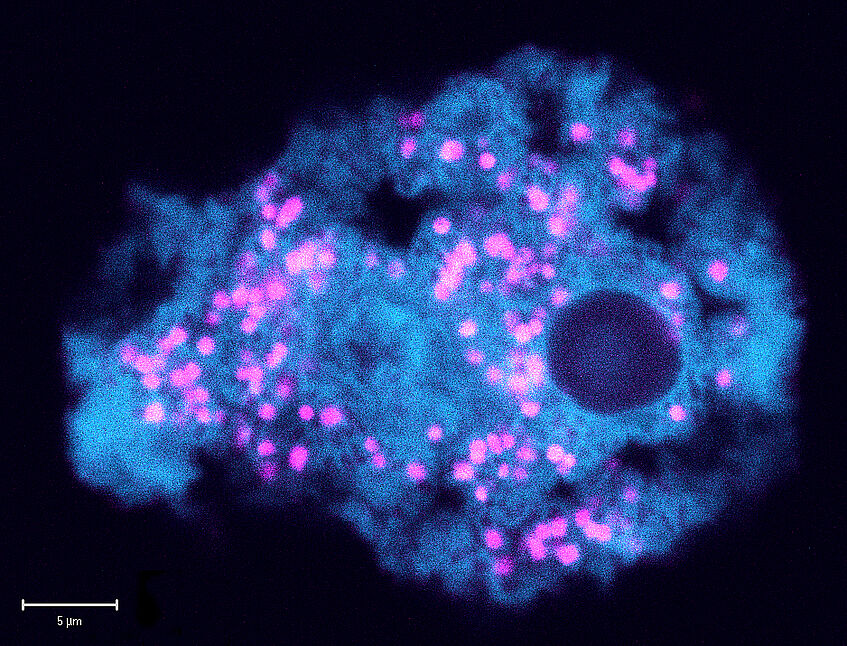Evolution and biology of strictly intracellular microbes

Chlamydiae are well-known as important pathogens of humans but have more recently also been found as symbionts of free-living amoebae. Molecular surveys suggest that the chlamydiae are highly diverse, likely infecting almost any animal lineage. They represent one of the evolutionary oldest strictly intracellular groups of microbes, with their last common ancestor having lived around one billion years ago.
Studying chlamydial symbionts such as Protochlamydia amoebophila and Parachlamydia acanthamoebae, the comparison with their pathogenic counterparts, as well as evolution experiments using these symbionts allow us to investigate the evolution of the intracellular lifestyle of chlamydiae and their adaptation to different eukaryotic hosts. This research is carried out within the group of Matthias Horn, together with Astrid Collingro.
Recent project: Chlamydial symbionts in dictyostelids
The soil amoeba Dictyostelium discoideum is one of the best-known protist model systems and famous for its so-called social life cycle, a conserved mechanism found in all dictyostelids. During this life cycle, tens of thousands of cells aggregate and develop multicellular structures, eventually leading to the formation of spores. Recent evidence suggests that in nature chlamydial symbionts are widespread among dictyostelids. In this project, we aim to understand the diversity of chlamydial symbionts in dictyostelids and ask how chlamydiae adapted to the specific social life cycle of dictyostelid amoebae.
Collaboration partners: Susanne DiSalvo (Southern Illinois University Edwardsville), Tamara Haselkorn (University of Central Arkansas), Thiery Soldati (University of Geneva).
Selected publications on this theme:
- Dharamshi JE, Köstlbacher S, Schön ME, Collingro A, Ettema TJG, Horn M. 2023. Gene gain facilitated endosymbiotic evolution of Chlamydiae. Nat Microbiol, 1: 40-54 http://dx.doi.org/10.1038/s41564-022-01284-9
- Köstlbacher S, Collingro A, Halter T, Schulz F, Jungbluth SP, Horn M. 2021. Pangenomics reveals alternative environmental lifestyles among chlamydiae. Nature Commun., 12: 4021; http://dx.doi.org/10.1038/s41467-021-24294-3
- Collingro A, Köstlbacher S, Horn M. 2020. Chlamydiae in the Environment. Trends Microbiol, 11: 877-888 http://dx.doi.org/10.1016/j.tim.2020.05.020
- Herrera P, Schuster L, Wentrup C, König L, Kempinger T, Na H, Schwarz J, Köstlbacher S, Wascher F, Zojer M, Rattei T, Horn M. 2020. Molecular causes of an evolutionary shift along the parasitism-mutualism continuum in a bacterial symbiont. Proc. Natl. Acad. Sci. U.S.A., 117: 21658-21666; http://dx.doi.org/10.1073/pnas.2005536117
- Lagkouvardos I, Weinmaier T, Lauro FM, Cavicchioli R, Rattei T, Horn M. 2014. Integrating metagenomic and amplicon databases to resolve the phylogenetic and ecological diversity of the Chlamydiae. ISME J. 1: 115-25; http://dx.doi.org/10.1038/ismej.2013.142
- Horn M. 2008. Chlamydiae as symbionts in eukaryotes. Ann. Rev. Microbiol. 62: 113-131. http://dx.doi.org/10.1146/annurev.micro.62.081307.162818
